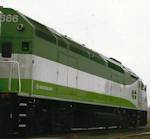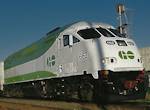MP40-3PH EXTERIOR DETAILS and CHANGES | ||||
| Old Paint scheme has ONTARIO and TRILLIUM LOGO on front sides below cab windows New paint scheme has removed the Ontario name and Trillium logo and added METROLINX at the rear of the long hood both sides (Click Image Buttons to enlarge) | Ontario/Trillium Logos (Old Paint)  | Metrolinx (New Paint/Repaints)  | No Ontario/Trillium Logos Also no logo on 607, 615, 647, 667-682 | GO662-GO643 Logo-less / Logos  |
| On first delivery, snow plow edges too high to allow for use of the front uncoupling lever - a welder first welded out a horizontal 'L' shape so the levers on both sides could be used Later plows came with either the wedge manufactured out or a smaller plow | Original Plow | Original Plow | Modified Cut Plow | Manufactured Shaped Plow |
| HEP exhaust stacks - several variations - after P1 flapper style gone (eg:)  New 647 HEP stacks almost flush on roof top New 647 HEP stacks almost flush on roof top | HEP Stacks: Original Flappers (eg:) | HEP Style 2: Taller Stacks (egs:) | HEP Style 3: Smaller Stacks than Style 2 (egs:) 600 to 602 & 604 to 656 | HEP Style 4: Cover (eg:) |
| UHF and VHF have a new location on locomotives 657 to 666 | UHF
UHF located on the slanted side behind the first set of grills on the long hood hogger side | VHF
VHF located on the slanted side behind the first set of grills on the long hood fireman's side | As new AC units are being added to the cab roof the UHF and VHF are being moved to locations like 657-666  (eg) 620 (eg) 620 | |
| Flanger cleaning rods and pads to clean flanges of gunk added to front #1 axle/wheels & rear #4 axle/wheels on 619, 621, 625, 639, 642 - Oct 2014 (Still on locos June 2016) | (eg:) 642 Note:white rods/red handles |   New AC units added to 557 to 666 Sept 2017 | ||
GO 664 first MP40 to have vinyl wrapping and note NO reflective strip (Nov 2017) -and- -and- GO 664 first to sport a new red/white reflective tape across the bumper strip above the knuckle (Nov 2017) | ||||
MP40PH-3 EARLY / CURRENT ISSUES |
In the first few months of their arrival, the MP40s had a number of issues (operating, practical, safety) - most have since been resolved: |
|